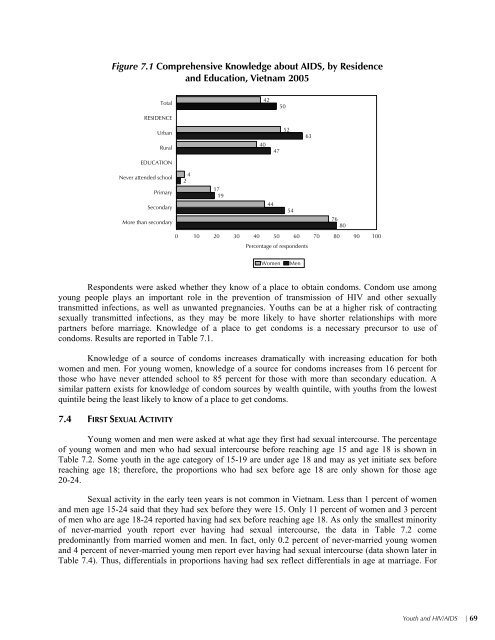Vietnam Population and AIDS Indicator Survey 2005 ... - Measure DHS
Vietnam Population and AIDS Indicator Survey 2005 ... - Measure DHS
Vietnam Population and AIDS Indicator Survey 2005 ... - Measure DHS
You also want an ePaper? Increase the reach of your titles
YUMPU automatically turns print PDFs into web optimized ePapers that Google loves.
Figure 7.1 Comprehensive Knowledge about <strong>AIDS</strong>, by Residence<br />
<strong>and</strong> Education, <strong>Vietnam</strong> <strong>2005</strong><br />
Total<br />
RESIDENCE<br />
42<br />
50<br />
Urban<br />
Rural<br />
40<br />
47<br />
52<br />
63<br />
EDUCATION<br />
4<br />
Never attended school<br />
2<br />
17<br />
Primary<br />
19<br />
44<br />
Secondary<br />
54<br />
76<br />
More than secondary<br />
80<br />
0 10 20 30 40 50 60 70 80 90 100<br />
Percentage of respondents<br />
Women<br />
Men<br />
Respondents were asked whether they know of a place to obtain condoms. Condom use among<br />
young people plays an important role in the prevention of transmission of HIV <strong>and</strong> other sexually<br />
transmitted infections, as well as unwanted pregnancies. Youths can be at a higher risk of contracting<br />
sexually transmitted infections, as they may be more likely to have shorter relationships with more<br />
partners before marriage. Knowledge of a place to get condoms is a necessary precursor to use of<br />
condoms. Results are reported in Table 7.1.<br />
Knowledge of a source of condoms increases dramatically with increasing education for both<br />
women <strong>and</strong> men. For young women, knowledge of a source for condoms increases from 16 percent for<br />
those who have never attended school to 85 percent for those with more than secondary education. A<br />
similar pattern exists for knowledge of condom sources by wealth quintile, with youths from the lowest<br />
quintile being the least likely to know of a place to get condoms.<br />
7.4 FIRST SEXUAL ACTIVITY<br />
Young women <strong>and</strong> men were asked at what age they first had sexual intercourse. The percentage<br />
of young women <strong>and</strong> men who had sexual intercourse before reaching age 15 <strong>and</strong> age 18 is shown in<br />
Table 7.2. Some youth in the age category of 15-19 are under age 18 <strong>and</strong> may as yet initiate sex before<br />
reaching age 18; therefore, the proportions who had sex before age 18 are only shown for those age<br />
20-24.<br />
Sexual activity in the early teen years is not common in <strong>Vietnam</strong>. Less than 1 percent of women<br />
<strong>and</strong> men age 15-24 said that they had sex before they were 15. Only 11 percent of women <strong>and</strong> 3 percent<br />
of men who are age 18-24 reported having had sex before reaching age 18. As only the smallest minority<br />
of never-married youth report ever having had sexual intercourse, the data in Table 7.2 come<br />
predominantly from married women <strong>and</strong> men. In fact, only 0.2 percent of never-married young women<br />
<strong>and</strong> 4 percent of never-married young men report ever having had sexual intercourse (data shown later in<br />
Table 7.4). Thus, differentials in proportions having had sex reflect differentials in age at marriage. For<br />
Youth <strong>and</strong> HIV/<strong>AIDS</strong> | 69








![Obtaining Informed Consent for HIV Testing [QRS4] - Measure DHS](https://img.yumpu.com/49850117/1/190x245/obtaining-informed-consent-for-hiv-testing-qrs4-measure-dhs.jpg?quality=85)








